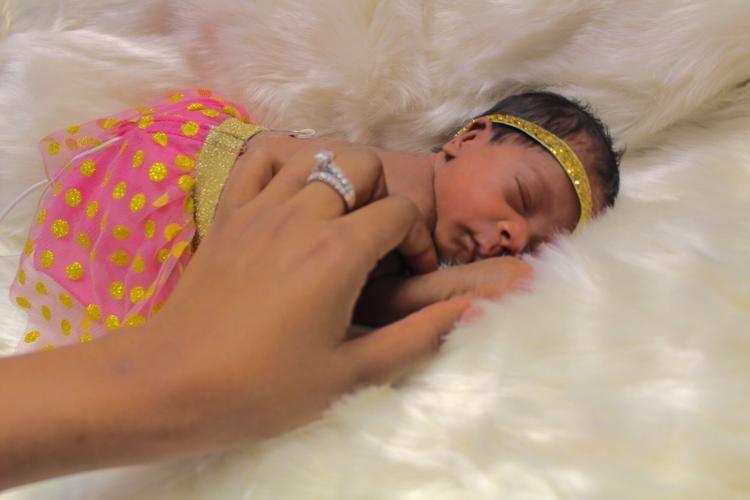For her newborn’s one-month photo shoot, Kheri Monks went shopping in the Barbie section at the toy store.
Gem weighed 1 pound, 11 ounces when she was born at 29 weeks. In the neonatal intensive care unit, Monks, an IT manager, dressed her in a pink tutu with gold polka dots made for a doll. Her wedding ring could have been a bracelet, easily fitting over her daughter’s wrist.
Almost two months after that photoshoot, the Monks family went home with Gem and a nasal cannula and apnea monitor after 80 days in the NICU.
But it was not their last stay. Over the next five years, Monks, now 40, had two more premature babies. No one has ever been able to tell her why her babies have always come dangerously early, but her experience reflects a troubling trend across the nation that is particularly dire in Louisiana.
Second only to Mississippi
The yearly rate of prematurity in the U.S. is around 10% of all births, according to the March of Dimes. In Louisiana, it’s 13.3%, making the state one of nine to earn an "F" on the March of Dimes annual report card for premature birth.
As a state, Louisiana ranked second only to Mississippi.
The 2023 report doles out grades to states based on rates from two years prior, assigning a grade based on the percentage of premature births.
Louisiana’s rate was a slight improvement from last year’s rate of 13.5%, but still the second-highest the state has seen in at least the last ten years.
The national average of 10.4% garnered the U.S. an overall grade of "D+." A rate of 7.7% or fewer preterm births earned a state an "A" grade, while a rate of 11.5% or more garnered an "F." No states received an "A."
Preterm birth is defined as a live birth occurring before 37 weeks. A full-term pregnancy is between 39 to 40 weeks. Babies born even a few weeks preterm are at a higher risk for death during infancy from infection, breathing problems, sudden infant death syndrome or brain bleeds, among other issues.
The report also looked at the 100 U.S. cities with the most live births and gave them grades. New Orleans and Baton Rouge, where Monks delivered her three babies, both received "F" grades, with 12.5% of births resulting in premature babies in Baton Rouge and 13.5% in New Orleans. Only Birmingham, Detroit and Cleveland ranked higher than New Orleans for the percentage of preterm births.
No clear answers
Monks had what she thought was a typical pregnancy before Gem’s early arrival in 2016. She was eating dinner in her Gonzales home on a Sunday when she felt a stiffening across her body. It became suddenly hard for her to breathe. She slapped the wall to get her husband’s attention, unable to speak through the pain.
At the hospital, her blood pressure was in the 200s. If she didn’t have the baby right now, she remembers the medical team saying, both she and the baby would die.

Kheri Monks' three pregnancies all came unexpectedly early. Her children are now ages 7, 5 and 2.
She had the baby on Monday. On Wednesday, the doctor at Woman’s Hospital came to her room and wrote “HELLP syndrome” on the whiteboard. It’s an acronym for hemolysis, elevated liver enzymes and low platelets, a life-threatening pregnancy complication. Nobody could tell her why she developed HELLP, but they did say her risk of future premature births was higher.
Despite a higher level of monitoring, Monks developed preeclampsia with her next two births, a condition that causes dangerously high blood pressure in pregnancy. Her second child, Jax, came at 31 weeks. Her third, Jon, came at 36.
“They just haven’t given a clear answer as to why,” said Monks. When she asked what she could do to prevent it, she was told, “You just can’t.”
Though medical researchers struggle to point to any one reason for the spike in premature deaths, it’s an indicator that population health is declining, said Robin Gruenfeld, director of collective impact at March of Dimes in New Orleans.
“Infants are the canary in the coal mine for population health,” said Gruenfeld. “You can see the suffering and the health and well-being of a population through the health and well-being of our infants.”
Smoking is the biggest risk factor for prematurity. Other factors that raise the risk of a premature birth are having high blood pressure, being overweight, having diabetes, carrying multiples, such as twins or triplets, or a previous preterm birth.
The report found that Black and Native American women are at a much higher risk of preterm birth. In Louisiana, the rate for White women was 11.2%. It jumped to 14.2% for Native American women and 17% for Black women – nearly one in every six babies.
Sometimes it's impossible to escape risk factors. The stress of poverty and living in environments with high risk of natural disasters and racism may also impact birth outcomes, said Tyra Gross, associate professor of public health at Xavier University of Louisiana.
“The same populations at risk for preterm birth are at higher risk for vulnerability to climate events and extreme weather,” said Gross.
A 2020 study of more than 32 million births in the U.S. found that women exposed to high temperatures or air pollution were more likely to have children who were premature, underweight or stillborn.
Today, Monks' children are 7, 4 and 2. Having a premature baby doesn’t end when families leave the hospital. Since Gem's early days, Monks balanced her job and motherhood with ongoing appointments for therapy for developmental delays related to prematurity, along with all the normal kid stuff, like schoolwork and sports. Her first two have been diagnosed with autism. Her third is also showing signs.
“I'm just doing whatever I can possibly do to close those gaps,” said Monks.



